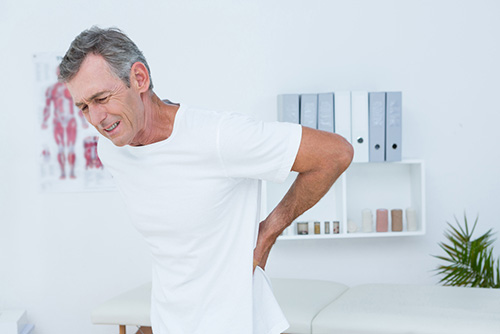Chronic back pain is real, and most people will experience it at some point in their lives. In fact, a 2012 American Physical Therapy Association survey found nearly two-thirds of Americans experience low-back pain but 37 percent do not seek professional help for pain relief. Whether it’s mild or severe, short or long-termed, low-back pain makes nearly every daily activity difficult and painful.

Your spine consists of vertebra and discs. Muscles, ligaments, cartilage and nerves make up the remainder of your spinal column, which acts as an expressway for nerves to travel through in route to the rest of the body. A problematic spine can cause a multitude of problems, even away from the spinal column, and leave you desperate for solutions. Here are some tips to alleviate low-back pain.
Exercise
The core is utilized in almost every activity you do throughout the day, from walking and bending to sitting and standing. This is why low-back pain is so debilitating.
When most people think of their core, they only picture the abdomen, specifically the frontal portions. But the core is actually a muscle group wrapping around your entire midsection between the pelvis and the rib cage. This includes your abdominals, obliques, and low-back muscles.
Exercise is vital to cardiovascular and musculoskeletal health. Plus, if you’re overweight, shedding some of those unwanted pounds can take off additional low-back pressure. Strengthening your core is not only a great solution, but will likely be a cornerstone of any physical therapy regime.
Glute/Hip Strength
The muscles attached to the core region—like the pelvic floor, hips and glutes—work in sync with your core; a problem in these groups can contribute to your low-back pain. Strengthening these regions can take pressure off your low-back while increasing flexibility can alleviate the pain as immobility often contributes to low-back pain.
Rest When Needed
Too much of anything causes problems. This is extremely important when dealing with low-back pain. While exercise alleviates pain, overuse is an issue and occurs in a shorter amount of time when the portion of the body is sore, injured or unhealthy. Whether it’s during exercise or work, taking a break when you feel pain is necessary.
Spinal Manipulation and Conservative Treatment
Recent updates to American College of Physicians guidelines emphasize the use of conservative treatment for low-back pain before moving on to drug treatments. Specifically, the guidelines recommend the first steps in treating back pain should be heat and ice, soft tissue massage, physical therapy, spinal adjustments and acupuncture, before moving on to painkillers, especially opioids. Doctors, physical therapists and chiropractors will team up and communicate with each other to establish the right treatment plan for you.
Medication
Aspirin (not to be given to children unless you’re instructed to do so by your orthopedic surgeon) and non-steroidal anti-inflammatory medicines reduce pain and swelling in pain-stricken regions. If deemed necessary, codeine and morphine may be used to help. Oral or injected steroids can also deliver a direct and high dose of anti-inflammatory relief.
In addition, physical bracers are often used. The take some pressure off the low-back and provide support, giving your low-back more time to heal be relieving some of the pressure and force on the area.
Physical Therapy
Your doctor may recommend physical therapy for your spinal problems. As stated above in the exercise section, strengthening core muscles and improving overall strength can alleviate pain and place the pressure on the newly-strengthened muscles and areas of the body built to withstand that pressure with proper form and posture.
Solution: Develop a plain with your physical therapist and doctor
A fine-tuned plan incorporating all these elements is an easy, relatively time efficient way to minimize lower back pain. In fact, when matched with a healthy diet, this may only take up a few hours of your week. If two hours seem lengthy, remember there are 168 hours in a week. Using only 2 to 4 of those hours to alleviate pain for the remaining 160+ hours is worth it.
Before developing a regimen, consult with your doctor and physical therapist (if you meet with one). They can help you develop a plan to meet your specific needs
Surgery
If non-invasive procedures do not work, surgery might be necessary. It’s important to note, surgery should only be considered when the doctor knows the exact cause contributing to your lower-back pain. Surgery is expensive, time-consuming and must be adequately planned. If doctors cannot find the source of your pain, surgery can very well be a waste of time and money for you, the doctor, and your insurance.
If there is a specific source of your pain and surgery is an option, you will be required to meet with a physical therapist after.

